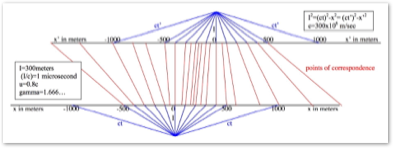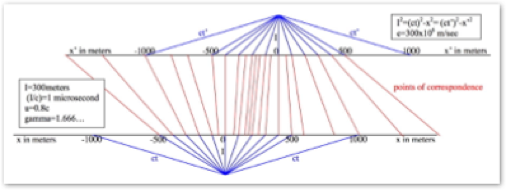

• A professor once said, “Don’t bite my finger. Look where I am pointing.” That applies here.
Special Relativity Theory (SRT) is considered the correct description of unaccelerated (inertial reference frame) motion. Some might even consider SRT ‘settled science’, with Newtonian Mechanics (NM) an adequate approximation at low relative speeds. It is claimed that experimental evidence proves the correctness of SRT although Dr. Howard Hayden pointed out in “Distinctions Between Galilean and Einsteinian Physics” (Galilean Electrodynamics; March/April 1992; Vol.3 No.2 pp. 23-27) that even though all the experiments were compatible with SRT, none of them were exclusive to it.
A number of people have questioned the correctness of SRT, often but not exclusively on philosophical grounds. Also there are paradoxes, such as the twin paradox and the pole and barn paradox, and does anyone truly understand time dilation?
All the so-called ‘problems’ of SRT can be cleared up by careful examination of SRT’s equations, all of which are derivable from the Relativistic Interval equation
I2 = (ct)2 – x2 = (ct´)2 – x´2 = (ct´´)2 – x´´2…
and the inclusion, where appropriate, of rest mass, mo .
Question. How far will an object travel in 1 microsecond (µs) at 0.8c according to SRT? x´=γ(x+vt) , x=0 , γ=(5/3) . The object will travel x´= 400m . How far will the light travel in 1µs ? 300m. Food for thought. How far will the object travel at one tenth that speed (.08c) for 10 times as long (10µs)? 240.77m. This seeming oddity is easily explained in these papers.
• The equation most crucial to understanding SRT (along with NM) is not Einstein’s transformation equations but the Relativistic Interval equation. With the transformation equations, when you multiply t´ by c , square the result, and subtract from it the square of the x´ equation, you get the SRT Interval equation. All of SRT can be derived from the Relativistic Interval Equation and rest mass (m0) .
The paper “The Beginning of Special Relativity Theory” (SRT) shows the parallel development from the Interval equation of both Newtonian Mechanics (NM) and Special Relativity theory (SRT) up to the point where they diverge, and what happens thereafter. You may be surprised to find that the Relativistic Interval , the ‘gamma’ (γ) function, and momentum all have the same numeric values in both SRT and NM. In addition, when comparing a moving reference frame to a non-moving reference frame, the NM velocity and the SRT velocity between them (which are never, ever the same numeric value) can both be expressed as a function of the γ function. This article cam also be reached by clicking “SR beginning” above.
• Einstein’s most famous equation,
E = mc2 ,
is actually incorrect according to SRT. The equation implies that mass increases (a small amount) with energy. Nothing in the universe has velocity or kinetic energy per se. Everything in the universe has velocity and kinetic energy with respect to everything else in the universe except those things which do not change distance with it over time. If Einstein’s version were correct, then everything in the universe would have an almost infinite number of masses, depending on which object moving with respect to it you choose! “SRT reveals that E=mc2 is flawed” shows that the correct form, according to Special Relativity Theory (SRT), is
E = γmc2 .
Article is also listed above as “E=mc2 —not”. See for yourself.
ª The paper “The End of Special Relativity Theory”, (listed above as "SRT End") published in a peer reviewed physics journal, details how any physical problem depiction in SRT is actually a 1:1 encryption of the Newtonian Mechanics (NM) description of the same physical situation. The resulting numbers, of course, are different. SRT has simply twisted space and time together unnecessarily into a twisted mess which decodes back into NM on a 1:1 basis. You need to check this out for yourself. The mathematics is no more than algebra.
• Einstein published an interesting short paper entitled “Does The Inertia Of A Body Depend Upon Its Energy Content?”. There is a lot to be learned from a re-examination of this paper. For this analysis and the paper, you may click on the title or "Energy & Mass" above.
• To show convincingly that SRT and NM are 1:1 ‘translations’ of each other, this paper, “How to derive Newtonian Mechanics Directly from Only the Equations of Special Relativity” obtains the NM transformation equation, x´=Vt + x , from only the SRT transformation equations. Listed above as “NM from SR”.
• This article was published in a peer reviewed physics journal but, unfortunately, there were a number of typographical errors, such as the equivalent of “x2 + P2 = x2”, which make it unreadable. “On the Multiple Meanings of 'Time' in SRT” is a thorough yet understandable look at the nature of SRT time and SRT ‘proper’ time and includes their relationship to NM time. It also covers the significance of “x” in the non-moving reference frame. Also accessed above as "sr times".
• “On the Strange Concept of Rest Mass Energy” shows that ‘rest mass energy’ can be ‘derived’ for NM as well as for SRT. It makes no sense in NM and not really in SRT either because when the algebra is continued, the ‘rest mass’ concept just disappears as shown in this paper. It is also listed above as "SR Rest Mass".
• The formulas of “A Simple Special Relativity model is offered which easily explains the 'twin paradox', why c is a maximum speed limit, and makes the concept of SR easy to understand” did not transfer properly so will have to be added eventually. However, Section 5.5, which derives the ‘γx’ and the ‘(v/c2)x’ of the SRT transformation equations, is correct in this screen version. The print version of the whole article is OK. If you click on the print button in the top of the screen version (also listed above as “SR Model”, you will get the double column print version which is also readable.
• “Correspondence Diagrams for NM and SR” shows that, using the Interval and the transformation equations, a correspondence diagram similar to the above can always be constructed for two reference frames or objects moving with respect to each other. Accessible also as "NM SR diagram" here or above right for the explanation.
Einstein’s Theory of Special Relativity
The above diagram shows the corresponding locations in two reference frames moving with respect to each other according to the Special Relativity (SR) transform equations. Click here for explanation.